
CERN
Encyclopedia
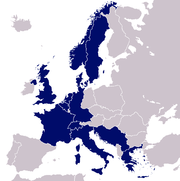

Particle physics
Particle physics is a branch of physics that studies the existence and interactions of particles that are the constituents of what is usually referred to as matter or radiation. In current understanding, particles are excitations of quantum fields and interact following their dynamics...
laboratory, which is situated in the northwest suburbs of Geneva
Geneva
Geneva In the national languages of Switzerland the city is known as Genf , Ginevra and Genevra is the second-most-populous city in Switzerland and is the most populous city of Romandie, the French-speaking part of Switzerland...
on the Franco–Swiss border (46°14′3"N 6°3′19"E). Established in 1954, the organization has twenty European member states.
The term CERN is also used to refer to the laboratory itself, which employs just under 2400 full-time employees/workers, as well as some 7931 scientists and engineers representing 608 universities and research facilities and 113 nationalities.
CERN's main function is to provide the particle accelerator
Particle accelerator
A particle accelerator is a device that uses electromagnetic fields to propel charged particles to high speeds and to contain them in well-defined beams. An ordinary CRT television set is a simple form of accelerator. There are two basic types: electrostatic and oscillating field accelerators.In...
s and other infrastructure needed for high-energy physics research. Numerous experiments have been constructed at CERN by international collaborations to make use of them. It is also the birthplace of the World Wide Web
World Wide Web
The World Wide Web is a system of interlinked hypertext documents accessed via the Internet...
. The main site at Meyrin
Meyrin
Meyrin is a municipality of the Canton of Geneva, Switzerland. It is the city located nearest to the CERN particle physics laboratory.Meyrin was originally a small agricultural village until the 1950s, when construction of CERN began just to the north...
also has a large computer centre containing very powerful data-processing facilities primarily for experimental data analysis and, because of the need to make them available to researchers elsewhere, has historically been a major wide area network
Wide area network
A wide area network is a telecommunication network that covers a broad area . Business and government entities utilize WANs to relay data among employees, clients, buyers, and suppliers from various geographical locations...
ing hub.
The CERN sites, as an international facility, are officially under neither Swiss nor French jurisdiction. Member states' contributions to CERN for the year 2008 totaled CHF
Swiss franc
The franc is the currency and legal tender of Switzerland and Liechtenstein; it is also legal tender in the Italian exclave Campione d'Italia. Although not formally legal tender in the German exclave Büsingen , it is in wide daily use there...
1 billion (approximately € 664 million).
History
The convention establishing CERN was ratified on 29 September 1954 by 12 countries in Western Europe. The acronym CERN originally stood, in French, for Conseil Européen pour la Recherche Nucléaire (European Council for Nuclear Research), which was a provisional council for setting up the laboratory, established by 12 European governments in 1952. The acronym was retained for the new laboratory after the provisional council was dissolved, even though the name changed to the current Organisation Européenne pour la Recherche Nucléaire (European Organization for Nuclear Research) in 1954. According to Lew KowarskiLew Kowarski
Lew Kowarski was a naturalized French physicist, of Russian-Polish descent. He was a lesser known but important contributor to nuclear science.-Early life:...
, a former director of CERN, when the name was changed the acronym could have become the awkward OERN, and Heisenberg
Werner Heisenberg
Werner Karl Heisenberg was a German theoretical physicist who made foundational contributions to quantum mechanics and is best known for asserting the uncertainty principle of quantum theory...
said that the acronym could "still be CERN even if the name is [not]".
Soon after its establishment the work at the laboratory went beyond the study of the atomic nucleus
Atomic nucleus
The nucleus is the very dense region consisting of protons and neutrons at the center of an atom. It was discovered in 1911, as a result of Ernest Rutherford's interpretation of the famous 1909 Rutherford experiment performed by Hans Geiger and Ernest Marsden, under the direction of Rutherford. The...
into higher-energy physics, which is mainly concerned with the study of interactions between particle
Subatomic particle
In physics or chemistry, subatomic particles are the smaller particles composing nucleons and atoms. There are two types of subatomic particles: elementary particles, which are not made of other particles, and composite particles...
s. Therefore the laboratory operated by CERN is commonly referred to as the European laboratory for particle physics (Laboratoire européen pour la physique des particules) which better describes the research being performed at CERN.
Scientific achievements
Several important achievements in particle physics have been made during experiments at CERN. They include:- 1973: The discovery of neutral currentNeutral currentWeak neutral current interactions are one of the ways in which subatomic particles can interact by means of the weak force. These interactions are mediated by the boson...
s in the GargamelleGargamelleGargamelle was a giant bubble chamber detector at CERN, designed mainly for the detection of neutrino interactions. Built in France, with a diameter of nearly 2 meters and 4.8 meters in length, Gargamelle held nearly 12 cubic meters of freon...
bubble chamber. - 1983: The discovery of W and Z bosonsW and Z bosonsThe W and Z bosons are the elementary particles that mediate the weak interaction; their symbols are , and . The W bosons have a positive and negative electric charge of 1 elementary charge respectively and are each other's antiparticle. The Z boson is electrically neutral and its own...
in the UA1 and UA2 experiments. - 1989: The determination of the number of light neutrinoNeutrinoA neutrino is an electrically neutral, weakly interacting elementary subatomic particle with a half-integer spin, chirality and a disputed but small non-zero mass. It is able to pass through ordinary matter almost unaffected...
families at the Large Electron–Positron Collider (LEP) operating on the Z boson peak. - 1995: The first creation of antihydrogenAntihydrogenAntihydrogen is the antimatter counterpart of hydrogen. Whereas the common hydrogen atom is composed of an electron and proton, the antihydrogen atom is made up of a positron and antiproton...
atoms in the PS210 experimentPS210 experimentThe PS210 experiment was the first experiment that led to the observation of antihydrogen atoms produced at the Low Energy Antiproton Ring at CERN in 1995. The antihydrogen atoms were produced in flight and moved at nearly the speed of light...
. - 1999: The discovery of direct CP-violation in the NA48 experiment.
- 2010: The isolation of 38 atoms of anti-hydrogen
- 2011: Maintaining anti-hydrogen for over 15 minutes
The 1984 Nobel Prize in physics was awarded to Carlo Rubbia
Carlo Rubbia
Carlo Rubbia Knight Grand Cross is an Italian particle physicist and inventor who shared the Nobel Prize in Physics in 1984 with Simon van der Meer for work leading to the discovery of the W and Z particles at CERN.-Biography:...
and Simon van der Meer
Simon van der Meer
Simon van der Meer was a Dutch particle accelerator physicist who shared the Nobel Prize in Physics in 1984 with Carlo Rubbia for contributions to the CERN project which led to the discovery of the W and Z particles, two of the most fundamental constituents of matter.-Biography:One of four...
for the developments that led to the discoveries of the W and Z bosons. The 1992 Nobel Prize in physics was awarded to CERN staff researcher Georges Charpak
Georges Charpak
Georges Charpak was a French physicist who was awarded the Nobel Prize in Physics in 1992.-Life:Georges Charpak was born to Jewish family in the village of Dąbrowica in Poland . Charpak's family moved from Poland to Paris when he was seven years old...
"for his invention and development of particle detectors, in particular the multiwire proportional chamber."
Computer science

World Wide Web
The World Wide Web is a system of interlinked hypertext documents accessed via the Internet...
began as a CERN project called ENQUIRE
ENQUIRE
ENQUIRE was an early software project written in 1980 by Tim Berners-Lee at CERN, which was the predecessor to the World Wide Web in 1989.It was a simple hypertext program that had some of the same ideas as the Web and the Semantic Web but was different in several important ways.According to...
, initiated by Tim Berners-Lee
Tim Berners-Lee
Sir Timothy John "Tim" Berners-Lee, , also known as "TimBL", is a British computer scientist, MIT professor and the inventor of the World Wide Web...
in 1989 and Robert Cailliau
Robert Cailliau
Robert Cailliau , born 26 January 1947, is a Belgian informatics engineer and computer scientist who, together with Sir Tim Berners-Lee, developed the World Wide Web.-Biography:...
in 1990. Berners-Lee and Cailliau were jointly honored by the Association for Computing Machinery
Association for Computing Machinery
The Association for Computing Machinery is a learned society for computing. It was founded in 1947 as the world's first scientific and educational computing society. Its membership is more than 92,000 as of 2009...
in 1995 for their contributions to the development of the World Wide Web.
Based on the concept of hypertext
Hypertext
Hypertext is text displayed on a computer or other electronic device with references to other text that the reader can immediately access, usually by a mouse click or keypress sequence. Apart from running text, hypertext may contain tables, images and other presentational devices. Hypertext is the...
, the project was aimed at facilitating sharing information among researchers. The first website went on-line in 1991. On 30 April 1993, CERN announced that the World Wide Web would be free to anyone. A copy of the original first webpage, created by Berners-Lee, is still published on the World Wide Web Consortium
World Wide Web Consortium
The World Wide Web Consortium is the main international standards organization for the World Wide Web .Founded and headed by Tim Berners-Lee, the consortium is made up of member organizations which maintain full-time staff for the purpose of working together in the development of standards for the...
's website as a historical document.

More recently, CERN has become a centre for the development of grid computing
Grid computing
Grid computing is a term referring to the combination of computer resources from multiple administrative domains to reach a common goal. The grid can be thought of as a distributed system with non-interactive workloads that involve a large number of files...
, hosting among others the Enabling Grids for E-sciencE (EGEE) and LHC Computing Grid
LHC Computing Grid
The Worldwide LHC Computing Grid is a computer network designed by CERN to handle the massive amounts of data produced by the Large Hadron Collider .-Description:A design report was published in 2005....
projects. It also hosts the CERN Internet Exchange Point
CERN Internet Exchange Point
The CERN Internet Exchange Point, or CIXP, is a historical European Internet landmark, through which the first pan-European Internet backbone and the first T1 connection to NSFnet were established in 1989 and 1990.*...
(CIXP), one of the two main Internet Exchange Point
Internet Exchange Point
An Internet exchange point is a physical infrastructure through which Internet service providers exchange Internet traffic between their networks . IXPs reduce the portion of an ISP's traffic which must be delivered via their upstream transit providers, thereby reducing the average per-bit...
s in Switzerland.
OPERA neutrino anomaly
On September 22, 2011, a paper from the OPERA CollaborationOPERA Experiment
The Oscillation Project with Emulsion-tRacking Apparatus is a scientific experiment for detecting tau neutrinos from muon neutrino oscillations. It is a collaboration between CERN in Geneva, Switzerland, and the Laboratori Nazionali del Gran Sasso in Gran Sasso, Italy and uses the CERN Neutrinos...
indicated detection of 17-GeV
Electronvolt
In physics, the electron volt is a unit of energy equal to approximately joule . By definition, it is equal to the amount of kinetic energy gained by a single unbound electron when it accelerates through an electric potential difference of one volt...
and 28-GeV muon neutrinos, sent 730 kilometers (454 miles) from CERN
CERN
The European Organization for Nuclear Research , known as CERN , is an international organization whose purpose is to operate the world's largest particle physics laboratory, which is situated in the northwest suburbs of Geneva on the Franco–Swiss border...
near Geneva, Switzerland to the Gran Sasso National Laboratory
Laboratori Nazionali del Gran Sasso
Laboratori Nazionali del Gran Sasso is a particle physics laboratory of the INFN, situated near the Gran Sasso mountain in Italy, between the towns of L'Aquila and Teramo, about 120 km from Rome. In addition to a surface portion of the laboratory, there are extensive underground facilities...
in Italy
Italy
Italy , officially the Italian Republic languages]] under the European Charter for Regional or Minority Languages. In each of these, Italy's official name is as follows:;;;;;;;;), is a unitary parliamentary republic in South-Central Europe. To the north it borders France, Switzerland, Austria and...
, traveling faster than light by a factor of 2.48×10−5 (approximately 1 in 40,322.58), a statistic with 6.0-sigma significance.
Current complex
CERN operates a network of six accelerators and a decelerator. Each machine in the chain increases the energy of particle beams before delivering them to experiments or to the next more powerful accelerator. Currently active machines are:- Two linear accelerators generate low energy particles. Linac2 accelerates protons to 50 MeV for injection into the Proton Synchrotron Booster (PSB), and Linac3 provides heavy ions at 4.2 MeV/uAtomic mass unitThe unified atomic mass unit or dalton is a unit that is used for indicating mass on an atomic or molecular scale. It is defined as one twelfth of the rest mass of an unbound neutral atom of carbon-12 in its nuclear and electronic ground state, and has a value of...
for injection into the Low Energy Ion Ring (LEIR). - The Proton Synchrotron BoosterProton Synchrotron BoosterThe Proton Synchrotron Booster, a synchrotron, is the first and smallest circular proton accelerator in the accelerator chain at the CERN Large Hadron Collider injection complex. The accelerator was built in 1972, and contains four superimposed rings with a radius of 25 meters...
increases the energy of particles generated by the proton linear accelerator before they are transferred to the other accelerators. - The Low Energy Ion Ring (LEIR) accelerates the ions from the ion linear accelerator, before transferring them to the Proton SynchrotronProton SynchrotronThe Proton Synchrotron is the first major particle accelerator at CERN, built as a 28 GeV proton accelerator in the late 1950s and put into operation in 1959. It takes the protons from the Proton Synchrotron Booster at a kinetic energy of 1.4 GeV and lead ions from the Low Energy Ion Ring at 72...
(PS). This accelerator was commissioned in 2005, after having been reconfigured from the previous Low Energy Antiproton RingLow Energy Antiproton RingThe Low Energy Anti-Proton Ring was an experiment at CERN designed to decelerate and store antimatter, to study the properties of antimatter and to create atoms of antihydrogen. The experiment was constructed in 1982 and operated until 1996, when it was converted into the Low Energy Ion Ring,...
(LEAR). - The 28 GeV Proton SynchrotronProton SynchrotronThe Proton Synchrotron is the first major particle accelerator at CERN, built as a 28 GeV proton accelerator in the late 1950s and put into operation in 1959. It takes the protons from the Proton Synchrotron Booster at a kinetic energy of 1.4 GeV and lead ions from the Low Energy Ion Ring at 72...
(PS), built in 1959 and still operating as a feeder to the more powerful SPSSuper Proton SynchrotronThe Super Proton Synchrotron is a particle accelerator of the synchrotron type at CERN. It is housed in a circular tunnel, in circumference, straddling the border of France and Switzerland near Geneva, Switzerland. The SPS was designed by a team led by John Adams, director-general of what was...
. - The Super Proton SynchrotronSuper Proton SynchrotronThe Super Proton Synchrotron is a particle accelerator of the synchrotron type at CERN. It is housed in a circular tunnel, in circumference, straddling the border of France and Switzerland near Geneva, Switzerland. The SPS was designed by a team led by John Adams, director-general of what was...
(SPS), a circular accelerator with a diameter of 2 kilometres built in a tunnel, which started operation in 1976. It was designed to deliver an energy of 300 GeV and was gradually upgraded to 450 GeV. As well as having its own beamlines for fixed-target experiments (currently COMPASSCOMPASS experimentThe NA58 experiment, or COMPASS is a fixed-target particle physics experiment at the Super Proton Synchrotron, a particle accelerator at the European Organization for Nuclear Research...
and NA62NA62 experimentThe NA62 experiment is a planned particle physics experiment at the North Area of the SPS accelerator at CERN. It aims to start physics data taking in 2014, when it will become the first in the world to probe the decays of the charged kaon with probabilities down to 10−12...
), it has been operated as a protonProtonThe proton is a subatomic particle with the symbol or and a positive electric charge of 1 elementary charge. One or more protons are present in the nucleus of each atom, along with neutrons. The number of protons in each atom is its atomic number....
–antiprotonAntiprotonThe antiproton is the antiparticle of the proton. Antiprotons are stable, but they are typically short-lived since any collision with a proton will cause both particles to be annihilated in a burst of energy....
colliderColliderA collider is a type of a particle accelerator involving directed beams of particles.Colliders may either be ring accelerators or linear accelerators.-Explanation:...
(the SpS collider), and for accelerating high energy electronElectronThe electron is a subatomic particle with a negative elementary electric charge. It has no known components or substructure; in other words, it is generally thought to be an elementary particle. An electron has a mass that is approximately 1/1836 that of the proton...
s and positronPositronThe positron or antielectron is the antiparticle or the antimatter counterpart of the electron. The positron has an electric charge of +1e, a spin of ½, and has the same mass as an electron...
s which were injected into the Large Electron–Positron Collider (LEP). Since 2008, it has been used to inject protons and heavy ionHeavy ionHeavy ion refers to an ionized atom which is usually heavier than helium. Heavy-ion physics is devoted to the study of extremely hot nuclear matter and the collective effects appearing in such systems, differing from particle physics, which studies the interactions between elementary particles...
s into the Large Hadron ColliderLarge Hadron ColliderThe Large Hadron Collider is the world's largest and highest-energy particle accelerator. It is expected to address some of the most fundamental questions of physics, advancing the understanding of the deepest laws of nature....
(LHC). - The On-Line Isotope Mass SeparatorOn-Line Isotope Mass SeparatorThe On-Line Isotope Mass Separator, also known as the ISOLDE Radioactive Ion Beam Facility, is a facility located at CERN on the PS Booster...
(ISOLDE), which is used to study unstable nucleiRadioactive decayRadioactive decay is the process by which an atomic nucleus of an unstable atom loses energy by emitting ionizing particles . The emission is spontaneous, in that the atom decays without any physical interaction with another particle from outside the atom...
. The radioactive ions are produced by the impact of protons at an energy of 1.0–1.4 GeV from the Proton Synchrotron Booster. It was first commissioned in 1967 and was rebuilt with major upgrades in 1974 and 1992. - REX-ISOLDE increases the charge states of ions coming from the ISOLDE targets, and accelerates them to a maximum energy of 3 MeV/u.
- The Antiproton DeceleratorAntiproton DeceleratorThe Antiproton Decelerator is a storage ring at the CERN laboratory in Geneva. It was built as a successor to the Low Energy Antiproton Ring and started operation in the year 2000...
(AD), which reduces the velocity of antiprotons to about 10% of the speed of lightSpeed of lightThe speed of light in vacuum, usually denoted by c, is a physical constant important in many areas of physics. Its value is 299,792,458 metres per second, a figure that is exact since the length of the metre is defined from this constant and the international standard for time...
for research into antimatterAntimatterIn particle physics, antimatter is the extension of the concept of the antiparticle to matter, where antimatter is composed of antiparticles in the same way that normal matter is composed of particles...
. - The Compact Linear ColliderCompact Linear ColliderThe Compact Linear Collider is a proposed linear particle accelerator under design at CERN. CLIC is separate from the International Linear Collider project, and differs from it using normal conducting cavities to achieve a higher planned energy of several TeV.Currently research is in progress to...
Test Facility, which studies feasibility issues for the future normal conducting linear collider project.
The Large Hadron Collider
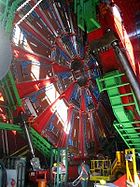
Large Hadron Collider
The Large Hadron Collider is the world's largest and highest-energy particle accelerator. It is expected to address some of the most fundamental questions of physics, advancing the understanding of the deepest laws of nature....
(LHC), and the experiments for it. The LHC represents a large-scale, worldwide scientific cooperation project.
The LHC tunnel is located 100 metres underground, in the region between the Geneva airport and the nearby Jura mountains
Jura mountains
The Jura Mountains are a small mountain range located north of the Alps, separating the Rhine and Rhone rivers and forming part of the watershed of each...
. It uses the 27 km circumference circular tunnel previously occupied by LEP
Large Electron-Positron Collider
The Large Electron–Positron Collider was one of the largest particle accelerators ever constructed.It was built at CERN, a multi-national centre for research in nuclear and particle physics near Geneva, Switzerland. LEP was a circular collider with a circumference of 27 kilometres built in a...
which was closed down in November 2000. CERN's existing PS/SPS accelerator complexes will be used to pre-accelerate protons which will then be injected into the LHC.
Seven experiments (CMS
Compact Muon Solenoid
The Compact Muon Solenoid experiment is one of two large general-purpose particle physics detectors built on the proton-proton Large Hadron Collider at CERN in Switzerland and France. Approximately 3,600 people from 183 scientific institutes, representing 38 countries form the CMS collaboration...
, ATLAS
ATLAS experiment
ATLAS is one of the six particle detector experiments constructed at the Large Hadron Collider , a new particle accelerator at the European Organization for Nuclear Research in Switzerland...
, LHCb
LHCb
LHCb is one of six particle physics detector experiments collecting data at the Large Hadron Collider accelerator at CERN. LHCb is a specialized b-physics experiment, that is measuring the parameters of CP violation in the interactions of b-hadrons...
, MoEDAL
MoEDAL experiment
The Monopole and Exotics Detector At the LHC is an international research collaboration whose spokesperson is the University of Alberta’s James Pinfold. MoEDAL is the seventh experiment at the LHC; it was approved and sanctioned by the CERN research board on May of 2010, and started its first test...
TOTEM
TOTEM
TOTal Elastic and diffractive cross section Measurement is one of the six detector experiments at the Large Hadron Collider at CERN. The other five are: ATLAS, ALICE, CMS, LHCb, and LHCf. It shares intersection point IP5 with the Compact Muon Solenoid...
, LHC-forward
LHCf
The LHCf is a special-purpose Large Hadron Collider experiment for astroparticle physics, and one of seven detectors in the LHC accelerator at CERN. The other six are: ATLAS, ALICE, CMS, MoEDAL, TOTEM, and LHCb...
and ALICE
A Large Ion Collider Experiment
ALICE is one of the six detector experiments at the Large Hadron Collider at CERN. The other five are: ATLAS, CMS, TOTEM, LHCb, and LHCf. ALICE is optimized to study heavy ion collisions. Pb-Pb nuclei collisions will be studied at a centre of mass energy of 2.76 TeV per nucleon...
) will run on the collider; each of them will study particle collisions from a different point of view, and with different technologies. Construction for these experiments required an extraordinary engineering effort. Just as an example, a special crane
Crane (machine)
A crane is a type of machine, generally equipped with a hoist, wire ropes or chains, and sheaves, that can be used both to lift and lower materials and to move them horizontally. It uses one or more simple machines to create mechanical advantage and thus move loads beyond the normal capability of...
had to be rented from Belgium in order to lower pieces of the CMS detector into its underground cavern, since each piece weighed nearly 2,000 tons. The first of the approximately 5,000 magnets necessary for construction was lowered down a special shaft at 13:00 GMT on 7 March 2005.
This accelerator has begun to generate vast quantities of data, which CERN streams to laboratories around the world for distributed processing (making use of a specialised grid
Grid computing
Grid computing is a term referring to the combination of computer resources from multiple administrative domains to reach a common goal. The grid can be thought of as a distributed system with non-interactive workloads that involve a large number of files...
infrastructure, the LHC Computing Grid
LHC Computing Grid
The Worldwide LHC Computing Grid is a computer network designed by CERN to handle the massive amounts of data produced by the Large Hadron Collider .-Description:A design report was published in 2005....
). In April 2005, a trial successfully streamed 600 MB/s to seven different sites across the world. If all the data generated by the LHC is to be analysed, then scientists must achieve 1,800 MB/s before 2008.
The initial particle beams were injected into the LHC August 2008. The first attempt to circulate a beam through the entire LHC was at 8:28 GMT on 10 September 2008, but the system failed because of a faulty magnet connection, and it was stopped for repairs on 19 September 2008.
The LHC resumed its operation on Friday the 20 November 2009 by successfully circulating two beams, each with an energy of 3.5 trillion electron volts. The challenge that the engineers then faced was to try and line up the two beams so that they smashed into each other. This is like "firing two needles across the Atlantic and getting them to hit each other" according to the LHC's main engineer Steve Myers, director for accelerators and technology at the Swiss laboratory.
At 1200 BST on Tuesday 30 March 2010 the LHC successfully smashed two proton particle beams travelling with 3.5 TeV (trillion electron volts) of energy, resulting in a 7 TeV event. However this is just the start of a long road toward the expected discovery of the Higgs boson
Higgs boson
The Higgs boson is a hypothetical massive elementary particle that is predicted to exist by the Standard Model of particle physics. Its existence is postulated as a means of resolving inconsistencies in the Standard Model...
. This is mainly because the amount of data produced is so huge it could take up to 24 months to completely analyse it all. At the end of the 7 TeV experimental period, the LHC will be shut down for maintenance for up to a year, with the main purpose of this shut down being to strengthen the huge magnets inside the accelerator. When it re-opens, it will attempt to create 14 TeV events.
Decommissioned accelerators
- The original linear accelerator (LINAC 1LINAC 1LINAC 1 was the first proton accelerater within CERN.The device was first active in 1958-59, . A beam injection-system was created in 1987 to be used with the accelerator....
). - The 600 MeV SynchrocyclotronSynchrocyclotronA synchrocyclotron is a cyclotron in which the frequency of the driving RF electric field is varied to compensate for relativistic effects as the particles' velocity begins to approach the speed of light...
(SC) which started operation in 1957 and was shut down in 1991. - The Intersecting Storage RingsIntersecting Storage RingsThe ISR was a particle accelerator at CERN. It was the world's first hadron collider, and ran from 1971 to 1984, with a maximum center of mass energy of 62 GeV...
(ISR), an early collider built from 1966 to 1971 and operated until 1984. - The Large Electron–Positron Collider (LEP), which operated from 1989 to 2000 and was the largest machine of its kind, housed in a 27 km-long circular tunnel which now houses the Large Hadron ColliderLarge Hadron ColliderThe Large Hadron Collider is the world's largest and highest-energy particle accelerator. It is expected to address some of the most fundamental questions of physics, advancing the understanding of the deepest laws of nature....
. - The Low Energy Antiproton RingLow Energy Antiproton RingThe Low Energy Anti-Proton Ring was an experiment at CERN designed to decelerate and store antimatter, to study the properties of antimatter and to create atoms of antihydrogen. The experiment was constructed in 1982 and operated until 1996, when it was converted into the Low Energy Ion Ring,...
(LEAR), commissioned in 1982, which assembled the first pieces of true antimatterAntimatterIn particle physics, antimatter is the extension of the concept of the antiparticle to matter, where antimatter is composed of antiparticles in the same way that normal matter is composed of particles...
, in 1995, consisting of nine atoms of antihydrogenAntihydrogenAntihydrogen is the antimatter counterpart of hydrogen. Whereas the common hydrogen atom is composed of an electron and proton, the antihydrogen atom is made up of a positron and antiproton...
. It was closed in 1996, and superseded by the Antiproton DeceleratorAntiproton DeceleratorThe Antiproton Decelerator is a storage ring at the CERN laboratory in Geneva. It was built as a successor to the Low Energy Antiproton Ring and started operation in the year 2000...
.
Sites
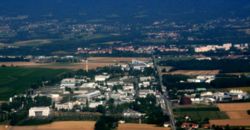
Meyrin
Meyrin is a municipality of the Canton of Geneva, Switzerland. It is the city located nearest to the CERN particle physics laboratory.Meyrin was originally a small agricultural village until the 1950s, when construction of CERN began just to the north...
site (also known as the West Area), which was originally built in Switzerland alongside the French border, but has been extended to span the border since 1965. The French side is under Swiss jurisdiction and so there is no obvious border within the site, apart from a line of marker stones. There are six entrances to the Meyrin site:
- A, in Switzerland. Open for all CERN personnel at specific times.
- B, in Switzerland. Open for all CERN personnel at all times. Often referred to as the main entrance.
- C, in Switzerland. Open for all CERN personnel at specific times.
- D, in Switzerland. Open for goods reception at specific times.
- E, in France. Open for French-resident CERN personnel at specific times. Controlled by customs personnel. Named "Porte Charles de Gaulle" in recognition of his role in the creation of the CERN.
- Tunnel entrance, in France. Open for equipment transfer to and from CERN sites in France by personnel with a specific permit. This is the only permitted route for such transfers. Under the CERN treaty, no taxes are payable when such transfers are made. Controlled by customs personnel.
The SPS and LEP/LHC tunnels are located underground almost entirely outside the main site, and are mostly buried under French farmland and invisible from the surface. However they have surface sites at various points around them, either as the location of buildings associated with experiments or other facilities needed to operate the colliders such as cryogenic plants and access shafts. The experiments themselves are located at the same underground level as the tunnels at these sites.
Three of these experimental sites are in France, with ATLAS in Switzerland, although some of the ancillary cryogenic and access sites are in Switzerland. The largest of the experimental sites is the Prévessin site, also known as the North Area, which is the target station for non-collider experiments on the SPS accelerator. Other sites are the ones which were used for the UA1, UA2 and the LEP experiments (the latter which will be used for LHC experiments).
Outside of the LEP and LHC experiments, most are officially named and numbered after the site where they were located. For example, NA32 was an experiment looking at the production of charm
Charm quark
The charm quark or c quark is the third most massive of all quarks, a type of elementary particle. Charm quarks are found in hadrons, which are subatomic particles made of quarks...
ed particles and located at the Prévessin (North Area) site while WA22 used the Big European Bubble Chamber
Big European Bubble Chamber
The Big European Bubble Chamber was a piece of equipment used to study particle physics at CERN. BEBC was installed at CERN in the early 1970s. It was a stainless-steel vessel filled with 35 cubic metres of liquid hydrogen. Charged particles left trails of bubbles as they passed through it. It...
(BEBC) at the Meyrin (West Area) site to examine neutrino interactions. The UA1 and UA2 experiments were considered to be in the Underground Area, i.e. situated underground at sites on the SPS accelerator.
Financing (Budget 2009)
| Member state | Contribution | Mil. CHF Swiss franc The franc is the currency and legal tender of Switzerland and Liechtenstein; it is also legal tender in the Italian exclave Campione d'Italia. Although not formally legal tender in the German exclave Büsingen , it is in wide daily use there... | Mil. EUR |
|---|---|---|---|
 Germany Germany |
19.88 % | 218.6 | 144.0 |
 Early Modern France Early Modern France |
15.34 % | 168.7 | 111.2 |
 United Kingdom United Kingdom |
14.70 % | 161.6 | 106.5 |
 Italy Italy |
11.51 % | 156.5 | 93.4 |
 Spain Spain |
8.52 % | 93.7 | 61.8 |
 Netherlands Netherlands |
4.79 % | 52.7 | 34.7 |
 Switzerland Switzerland |
3.01 % | 33.1 | 21.8 |
 Poland Poland |
2.85 % | 31.4 | 20.7 |
 Belgium Belgium |
2.77 % | 30.4 | 20.1 |
 Sweden Sweden |
2.76 % | 30.4 | 20.0 |
 Norway Norway |
2.53 % | 27.8 | 18.3 |
 Austria Austria |
2.24 % | 24.7 | 16.3 |
 Greece Greece |
1.96 % | 20.5 | 13.5 |
 Denmark Denmark |
1.76 % | 19.4 | 12.8 |
 Finland Finland |
1.55 % | 17.0 | 11.2 |
 Czech Republic Czech Republic |
1.15 % | 12.7 | 8.4 |
 Portugal Portugal |
1.14 % | 12.5 | 8.2 |
 Hungary Hungary |
0.78 % | 8.6 | 5.6 |
 Slovakia Slovakia |
0.54 % | 5.9 | 3.9 |
 Kingdom of Bulgaria Kingdom of Bulgaria |
0.22 % | 2.4 | 1.6 |
| Total | 100 % | 1098.6 | 724.0 |
Exchange rates: 1 CHF = 0,829 EUR (19 Sep 2011)
Member states
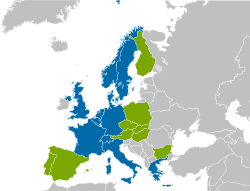
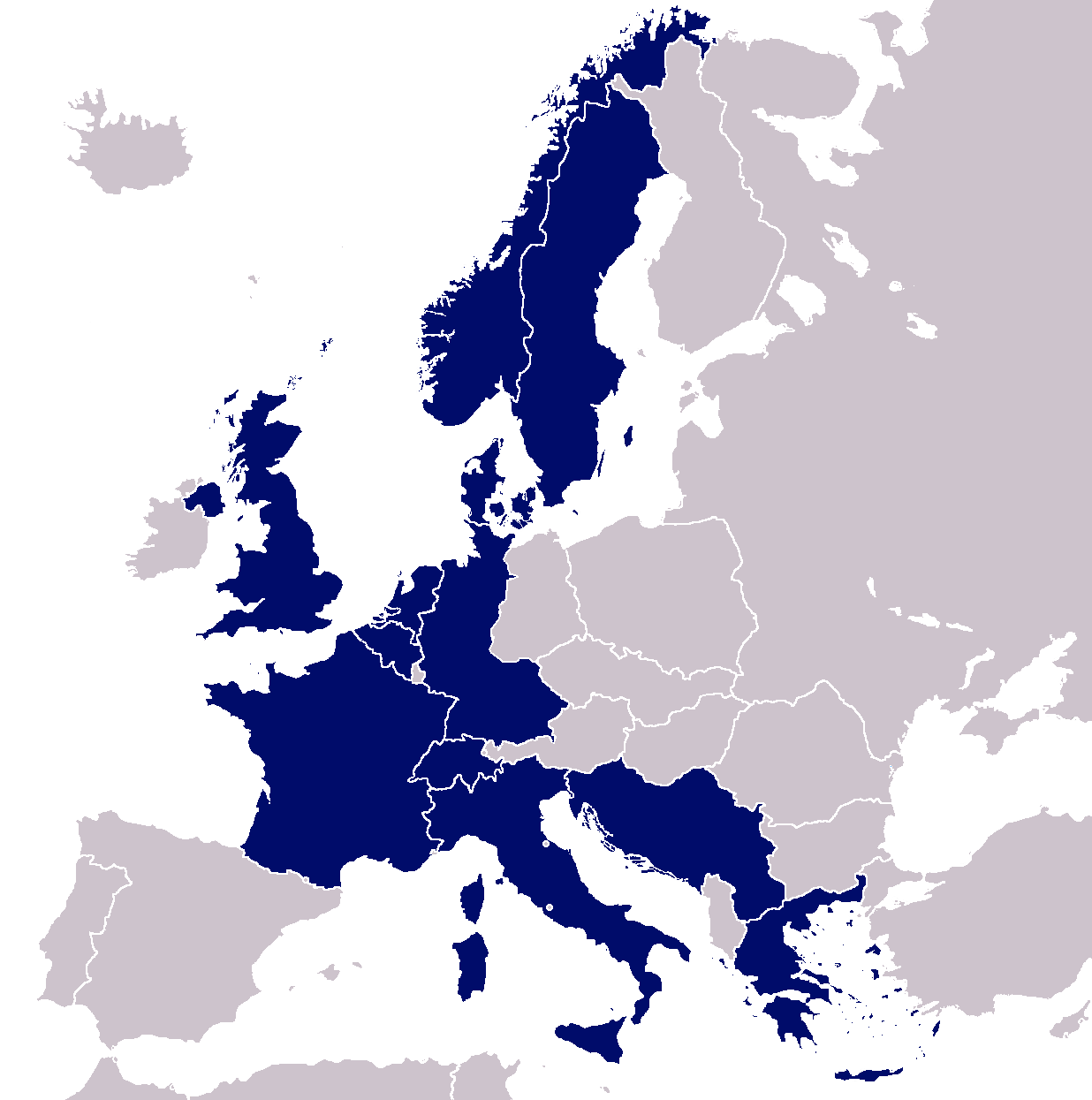
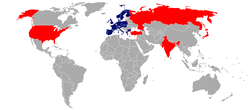
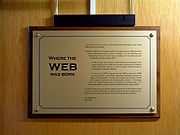
West Germany
West Germany is the common English, but not official, name for the Federal Republic of Germany or FRG in the period between its creation in May 1949 to German reunification on 3 October 1990....
) (later withdrawn).
All founding members have so far remained in the CERN organisation, except Yugoslavia which left in 1961 and never re-joined.
Since its foundation, CERN regularly accepted new members. All new members have remained in the organisation continuously since their acceptance, except Spain which joined in 1961, withdrew eight years later, and joined anew in 1983. CERN's membership history is as follows: joined in 1959, bringing the total number of members to thirteen. left in 1961 (twelve members) joined in 1961 (thus increasing the number of member states to 13 again), left in 1969 (twelve members), rejoined in 1983 (thirteen members) joined in 1985 (fourteen member states) joined in 1991 joined in 1991 (together with Finland bringing the number of participating member states to sixteen) joined in 1992 (seventeen members) joined in 1993 joined in 1993 (together with Czech Republic increasing the total members to nineteen) joined in 1999 (twenty member states)
There are currently twenty member countries, eighteen of which are also European Union member states. became a candidate for accession to CERN in 2010 and will become a member country in 2015. became an associate member in 2011, with a decision to be made on its full membership in 2013.
Four countries applying for membership have all formally confirmed their wish to become members. since 14 February 2006 Non-Member State status since 8 June 2001 Non-Member State status since 7 January 1991 Non-Member State status since 1961 Observer State status
Five countries have observer status: – since 1961 – since 1993 – since 1995 – since 1997 – since 2002
Also observers are the following international organizations: – since 1954 European Commission
European Commission
The European Commission is the executive body of the European Union. The body is responsible for proposing legislation, implementing decisions, upholding the Union's treaties and the general day-to-day running of the Union....
– since 1985
Non-Member States (with dates of Co-operation Agreements) currently involved in CERN programmes are: – 11 March 1992 – 25 March 1994 – 1 November 1991 – 3 December 1997 – 28 June 1994 – 19 February 1990 & October 2006 – 11 October 1996 – 10 October 1991 – 12 July 1991, 14 August 1997 & 17 February 2004 – 15 May 1993 – 18 July 1991 – 14 February 2006 – 16 January 2006 – 23 April 1996 – 11 October 1996 – 11 September 1996 – 5 July 2001 – 9 November 2004 – 27 April 2009 – 20 February 1998 – 12 October 1990 – 14 April 1997 – 4 December 2003 – 1 November 1994. The possibility of Pakistan becoming an Observer State has been raised on various occasions. – 23 February 1993 – 1 October 1991. Since 12 December 2008 it has the Status of Candidate for Accession to Membership. – 21 January 2006 – 8 June 2001. In 2008 it applied for accession to CERN as a Member State. Since 19 December 2010 it has the Status of Candidate for Accession to Membership. – 7 January 1991 – 4 July 1992 – 25 October 2006. – 18 January 2006 – 2 April 1993
| Maps of the history of CERN membership |
|---|
Public exhibits
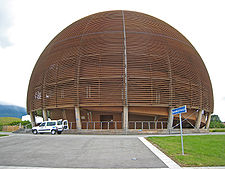
- The Globe of Science and InnovationThe Globe of Science and InnovationThe Globe of Science and Innovation is a landmark of CERN, it seeks to inform visitors about the significant research at CERN. The structure is 27 metres high and 40 metres wide and is wooden representing Sustainable development. - Exhibitions :...
, which opened in late 2005 and is used four times a week for special exhibits. - The Microcosm museumMicrocosm (CERN)Microcosm is a museum of particle physics located at CERN in the Canton of Geneva, Switzerland, near the town of Meyrin. It covers a broad range of particle physics topics, as well as the entire history of CERN...
on particle physicsParticle physicsParticle physics is a branch of physics that studies the existence and interactions of particles that are the constituents of what is usually referred to as matter or radiation. In current understanding, particles are excitations of quantum fields and interact following their dynamics...
and CERN history. - The HinduHinduHindu refers to an identity associated with the philosophical, religious and cultural systems that are indigenous to the Indian subcontinent. As used in the Constitution of India, the word "Hindu" is also attributed to all persons professing any Indian religion...
deityDeityA deity is a recognized preternatural or supernatural immortal being, who may be thought of as holy, divine, or sacred, held in high regard, and respected by believers....
, ShivaShivaShiva is a major Hindu deity, and is the destroyer god or transformer among the Trimurti, the Hindu Trinity of the primary aspects of the divine. God Shiva is a yogi who has notice of everything that happens in the world and is the main aspect of life. Yet one with great power lives a life of a...
engaging in the NatarajaNatarajaNataraja or Nataraj , The Lord of Dance; Tamil: கூத்தன் ;Telugu:నటరాజ is a depiction of the Hindu god Shiva as the cosmic dancer Koothan who performs his divine dance to destroy a weary universe and make preparations for god Brahma to start the process of creation...
dance, parallelling the movements or “dance” of subatomic particles.
In popular culture
- CERN's Large Hadron Collider is the subject of a (scientifically accurate) rapHip hop musicHip hop music, also called hip-hop, rap music or hip-hop music, is a musical genre consisting of a stylized rhythmic music that commonly accompanies rapping, a rhythmic and rhyming speech that is chanted...
video starring Katherine McAlpineKatherine McAlpineKatherine McAlpine is an American science journalist. In 2008 while working for CERN, McAlpine wrote, produced and performed in the YouTube video "Large Hadron Rap" under the pseudonym "alpinekat"...
with some of the facility's staff. - CERN's is depicted in an episode of South ParkSouth ParkSouth Park is an American animated television series created by Trey Parker and Matt Stone for the Comedy Central television network. Intended for mature audiences, the show has become famous for its crude language, surreal, satirical, and dark humor that lampoons a wide range of topics...
(Season 13, Episode 6) called "Pinewood Derby". Randy Marsh, the father of one of the main characters, breaks into the "Hadron Particle Super Collider in Switzerland" and steals a "superconducting bending magnet created for use in tests with particle acceleration" to use in his son Stan's Pinewood Derby racer. Randy breaks into CERN dressed in disguise as Princess Leia from the Star Wars saga. The break-in is captured on surveillance tape which is then broadcast on the news. - CERN is depicted in the visual novel (later adapted into an anime series) Steins;GateSteins;Gateis a Japanese visual novel developed by 5pb. and Nitroplus, and was released on October 15, 2009 for the Xbox 360. This is the two companies' second time collaborating together after Chaos;Head. A port to the Windows operating system on the PC was released on August 26, 2010 and a port for Sony's...
under the name SERN. In the video game, SERN is a shadowy organization that has been researching time travel and attempts to use it to restructure and control the world in the near future.
See also
- FermilabFermilabFermi National Accelerator Laboratory , located just outside Batavia, Illinois, near Chicago, is a US Department of Energy national laboratory specializing in high-energy particle physics...
- Large Hadron ColliderLarge Hadron ColliderThe Large Hadron Collider is the world's largest and highest-energy particle accelerator. It is expected to address some of the most fundamental questions of physics, advancing the understanding of the deepest laws of nature....
- List of Directors General of CERN
- Nederlandse Organisatie voor Wetenschappelijk OnderzoekNederlandse Organisatie voor Wetenschappelijk OnderzoekThe Nederlandse Organisatie voor Wetenschappelijk Onderzoek is a scientific research organization in the Netherlands....
- Science and technology in SwitzerlandScience and technology in SwitzerlandScience and technology in Switzerland play an important role in economy as very few natural resources are available in the country. The Swiss National Science Foundation, mandated by the Federal government, is the most important institute promoting scientific research.The raw output of scientific...
- SLAC National Accelerator LaboratorySLAC National Accelerator LaboratoryThe SLAC National Accelerator Laboratory, originally named Stanford Linear Accelerator Center, is a United States Department of Energy National Laboratory operated by Stanford University under the programmatic direction of the U.S...

